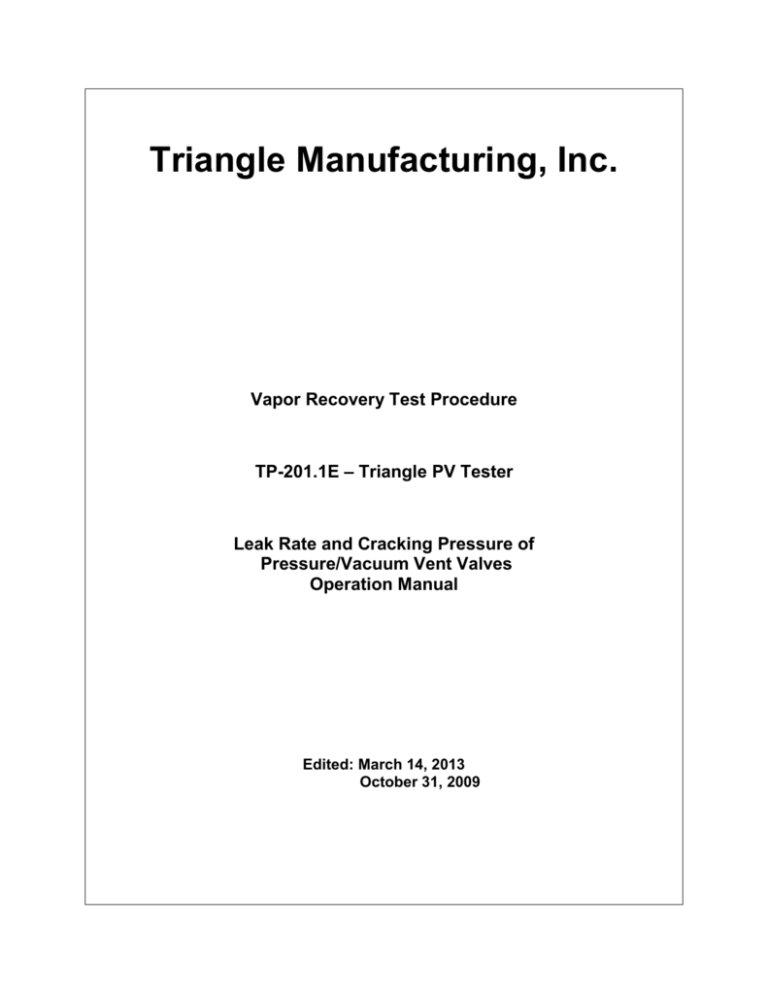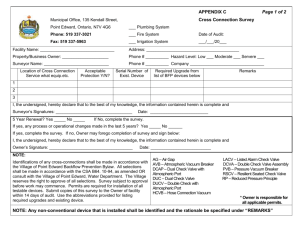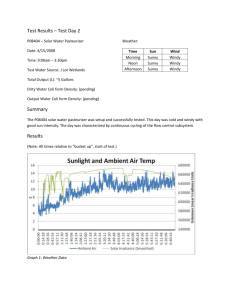Triangle_PV_Manual_2 - Triangle Manufacturing, Inc.
advertisement

Triangle Manufacturing, Inc. Vapor Recovery Test Procedure TP-201.1E – Triangle PV Tester Leak Rate and Cracking Pressure of Pressure/Vacuum Vent Valves Operation Manual Edited: March 14, 2013 October 31, 2009 Triangle Manufacturing, Inc. Vapor Recovery Test Procedure TP-201.1E Leak Rate and Cracking Pressure of Pressure/Vacuum Vent Valves Definitions common to all certification and test procedures are in: D-200 Definitions for Vapor Recovery Procedures For the purpose of this procedure, the term "CARB" refers to the California Air Resources Board, and the term "Executive Officer" refers to the CARB Executive Officer or his or her authorized representative or designate. 1. PURPOSE AND APPLICABILITY The purpose of this procedure is to determine the pressure and vacuum at which a Pressure-/Vacuum Vent Valve (P/V Valve) actuates, and to determine the volumetric leak rate at a given pressure as specified in CP-201, Certification Procedure for Vapor Recovery Systems at Gasoline Dispensing Facilities. This procedure is applicable for certification and compliance testing of P/V Valves. 2. PRINCIPLE AND SUMMARY OF TEST PROCEDURE The volumetric leak rate of a P/V Valve is determined by measuring the positive and negative flow rates at corresponding pressures. The positive and negative cracking pressures of the valve are determined by measuring the pressure at which the P/V Valve opens to atmospheric pressure. With the exception of certification testing performed by the Executive Officer, these measurements are determined by removing the P/V Valve and conducting the test on a test stand. A flow metering device is used to introduce flow while measuring pressure. 3. BIASES AND INTERFERENCES 3.1 Installing a P/V Valve onto the test stand in a manner that is not in accordance with the manufacturer’s recommended installation instructions can produce erroneous results. 3.2 Leaks in the test stand or test equipment can produce erroneous results. 4. SENSITIVITY, RANGE, AND PRECISION 4.1 Electronic Pressure Measuring Device. Minimum sensitivity shall be 0.01 inches H2O with a maximum full-scale range of 20 inches H2O and minimum accuracy of plus or minus 0.50 percent full-scale range. Triangle Manufacturing, Inc. March 14, 2013 TP-201.1E - Triangle, Page 1 4.2 Flow Meter. The measurable leak rate is dependent upon the sensitivity, range and precision of the flow meter used for testing. For rotameters, the flow meter minimum sensitivity shall be 12.5 ml/min (.026 CFH) with minimum accuracy of 5 percent full-scale. The device scale shall be 150mm (5.91 inches) tall to provide a sufficient number of graduations for readability. 5. EQUIPMENT 5.1 Nitrogen. Use commercial grade gaseous nitrogen in a high-pressure cylinder with a regulator valve. 5.2 Vacuum Generating Device. device. 5.3 Electronic Pressure Gauge. Use an electronic pressure gauge or digital manometer that conforms to the minimum requirements listed in section 4 to measure the pressure inside of the test stand. 5.4 Flow Metering Device(s). Use a Rotameter as described below to measure or introduce a volumetric flow rate. Use a commercially available vacuum generating 5.4.1 Rotameters. Two (2) devices required. Use two Flow Meters with minimum specifications described in Section 4 to measure or introduce flow rates. One meter shall use a needle valve oriented for introducing positive flow and the other using an inverted needle valve for introducing vacuum. 6. PRE-TEST PROCEDURES 6.1 All pressure measuring device(s) shall be bench calibrated using a reference gauge, incline manometer or NIST traceable standard at least once every six (6) months. Calibration shall be performed at 20, 50, and 80 percent of full scale. Accuracy shall be within five (5) percent at each of these calibration points. 6.2 Electronic pressure measuring devices shall be warmed up for a period of fifteen minutes and zeroed immediately prior to testing using the zero gauge pressure adjustment knob located on the instrument. 6.3 The Flow Metering device(s) shall be calibrated using a reference meter or NIST traceable standard. Calibrations shall be performed at 20, 50, and 80 percent of fullscale range and shall take place at a minimum of once every six (6) months. 6.4 Leak check the test stand assembly prior to installing the P/V Valve. (a) Install a 2-inch plug into the riser. (b) Attach a digital manometer and visually check all fittings for tightness and proper assembly. (c) Set nitrogen regulator to less than 10 psi. Close Bypass and both rotameter valves. Set Test and Supply valves to pressure, Triangle Manufacturing, Inc. March 14, 2013 TP-201.1E - Triangle, Page 2 (d) Slowly open left pressure rotameter valve to establish a stable gauge pressure in the test stand between 18 and 21 inches water column and allow pressure to stabilize. (e) Monitor the pressure for one (1) minute and see if it drops more than 1 inch water column which could indicate a leak. If drop is less than 1 inch water column, the test stand is leak tight. (f) Check for leaks by applying a leak detection solution around all fittings and joints and by observing the pressure for pressure changes that may identify a leak. (g) If soap bubbles form or the test stand pressure will not stabilize, repeat (a) through (e); it may be necessary to place the test apparatus in an environment that is free from the effects of wind, temperature or sunlight. (h) Open Bypass valve to vent. 7. TEST PROCEDURE 7.1 Install the P/V Valve in an upright position following the installation instructions provided by the manufacturer. Incorrectly installing the valve will invalidate any pressure versus flow rate measurement. 7.2 Positive Leak Rate. 1. Close the left Pressure Rotameter control valve, 2. Close the bypass valve on back of tester, 3. Connect regulated N2 supply, 4. Turn “N2 Supply Valve” to pressure, 5. Turn “Test Valve” to pressure, 6. Slowly open the control valve on the Pressure Rotameter until the pressure stabilizes at the positive leak rate pressure described in CP-201 section 3. Maintain steady state pressure by using the control valve for at least ten (10) seconds. Steady state flow is indicated by a pressure change of no more than 0.05 inches H2O on the pressure gauge. Record the final flow rate on the data sheet and close the control valve. 7.3 Positive Cracking Pressure. Open the bypass valve to route the flow outside of the test assembly. Open the control valve on the Pressure Rotameter to establish a flow rate of 0.25 cfh. Once flow is stabilized, close the bypass valve to route the flow into the test assembly. Observe the pressure. The P/V Valve should “crack” at a pressure within the range of positive cracking pressure as described in CP-201 section 3. This is marked by a sudden drop in pressure. Record the cracking pressure (highest pressure achieved) on the data sheet and close the control valve. Triangle Manufacturing, Inc. March 14, 2013 TP-201.1E - Triangle, Page 3 7.4 Negative Leak Rate. 1. Close the right Vacuum Rotameter control valve, 2. Close the bypass valve on back of tester, 3. Turn “N2 Supply Valve” to vacuum, 4. Turn “Test Valve” to vacuum 5. Slowly open the control valve on the Vacuum Rotameter until the vacuum stabilizes at the negative leak rate pressure described in CP-201 section. Maintain steady state vacuum by using the control valve for at least ten (10) seconds. Steady state flow is indicated by a pressure change of no more than 0.05 inches H2O on the pressure gauge. Record the final flow rate on the data sheet and close the control valve. 7.5 Negative Cracking Pressure. Open the bypass valve to route the flow outside of the test assembly. Open the control valve on the Vacuum Rotameter to establish a negative flow rate of 0.42 cfh. Once flow is stabilized, close the bypass valve to route the flow into the test assembly. Observe the pressure. The P/V Valve should “crack” at a pressure within the range of negative cracking pressure as described in CP-201 section 3. This is marked by a sudden drop in vacuum. Record the cracking pressure (highest vacuum achieved) on the data sheet and close the control valve. 8. CALCULATING RESULTS 8.1 Testing standards: The test standards are typically listed on the PV valve itself as well as in the PV valve manufacturing documents. A typical standard would be: Pressure Settings: Leakrate at +2.0 inches H2O 0.17 CFH Cracking pressure 2.5 to 6.0 inches H2O Positive Pressure Vacuum Settings: Cracking vacuum 6.0 to 10.0 inches H2O Negative Pressure Leakrate at -4.0 inches H2O 0.63 CFH Commonly used flow rate conversions: 1 CFH = 471.95 ml/min Example: Convert 0.17 CFH to ml/min: 0.17 CFH (471.95) = 80 ml/min 1 ml/min = 0.00212 CFH Example: Convert 100 ml/min to CFH: 100 ml/min (0.00212) = 0.21 CFH Triangle Manufacturing, Inc. March 14, 2013 TP-201.1E - Triangle, Page 4 10. REPORTING RESULTS 10.1 Record the station or location name, address and tester information on Form 1. 10.2 Record the P/V Valve manufacturer’s name and model number on Form 1. 10.3 Record the results of the test(s) on Form 1. Use additional copies of Form 1 if needed to record additional P/V Valve tests. 10.4 Alternate data sheets or Forms may be used provided they contain the same parameters as identified on Form 1. 10.5 Use the formulas and example equation provided in Section 9 to convert the flow measurements into units of cubic feet per hour (CFH). 10.6 For certification testing, compare results to the performance standards listed in Table 3-1 of CP-201. For compliance testing, compare the results to the manufacturer’s specifications listed on the P/V Valve for both leak rate and cracking pressure. For volumetric leak rates less than the manufacturers specified leakrate and cracking pressures within the manufacturers specified range, circle Pass on the data sheet where provided. If either the volumetric leak rate or cracking pressure exceeds the manufacturers specifications, circle Fail on the data sheet where provided. Triangle Manufacturing, Inc. March 14, 2013 TP-201.1E - Triangle, Page 5 Form 1 Pressure/Vacuum (P/V) Vent Valve Data Sheet Facility Name: Test Date: Address: Test Company: City : Tester Name: P/V Valve Manufacturer: Model Number: Manufacturers Specified Positive Leak Rate (CFH): Manufacturers Specified Negative Leak Rate (CFH): Measured Positive Leak Rate (CFH): Measured Negative Leak Rate (CFH): Positive Cracking Pressure (in. H2O): Negative Cracking Pressure (in. H2O): P/V Valve Manufacturer: Model Number: Manufacturers Specified Positive Leak Rate (CFH): Manufacturers Specified Negative Leak Rate (CFH): Measured Positive Leak Rate (CFH): Measured Negative Leak Rate (CFH): Positive Cracking Pressure (in. H2O): Negative Cracking Pressure (in. H2O): P/V Valve Manufacturer: Model Number: Manufacturers Specified Positive Leak Rate (CFH): Manufacturers Specified Negative Leak Rate (CFH): Measured Positive Leak Rate (CFH): Measured Negative Leak Rate (CFH): Positive Cracking Pressure (in. H2O): Negative Cracking Pressure (in. H2O): P/V Valve Manufacturer: Model Number: Manufacturers Specified Positive Leak Rate (CFH): Manufacturers Specified Negative Leak Rate (CFH): Measured Positive Leak Rate (CFH): Measured Negative Leak Rate (CFH): Positive Cracking Pressure (in. H2O): Negative Cracking Pressure (in. H2O): Pass Fail Pass Fail Pass Fail Pass Fail Triangle Manufacturing, Inc. March 14, 2013 TP-201.1E - Triangle, Page 6






